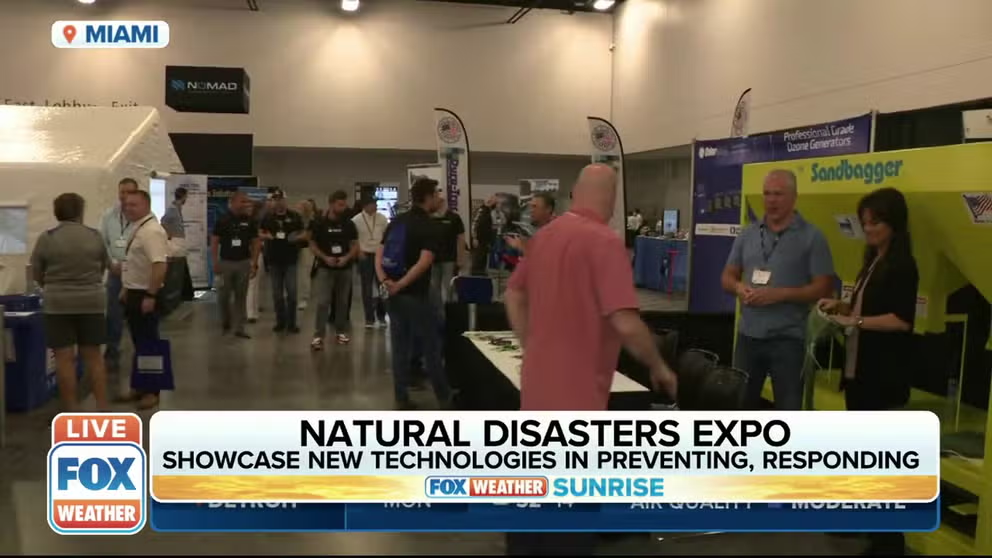From forecasting to flood mitigation, it's all at the Natural Disaster Expo
Two-day expo brings together experts in flooding, wildfires, earthquakes and storms
Expo to showcase new technologies in preventing, responding to natural disasters
Innovative thinkers in emergency response and natural disaster preparedness will gather in South Florida for the Natural Disaster Expo this week.
MIAMI BEACH, Fla. – Chainsaws, water purification systems, mobile medical bays, foldable housing, you name it. If it could help a community recover after a weather-related event, it's on display in Miami Beach this week for the 2022 Natural Disaster Expo.
More than 300 disaster-response and mitigation vendors are at the 500,000-square-foot Miami Beach Convention Center, along with top officials from FEMA, NOAA and NASA. The expo is like the Super Bowl for weather, disaster response and preparedness. The two-day event is divided up into four categories of topics: heat and fire, earthquakes, flooding and storms.
Natural disasters displace approximately 1.6 million people in the U.S. every year. Numerous housing solutions were set up inside the Miami Beach Convention Center.
Startup Foldum Corp. makes temporary housing powered by solar energy, including bunk beds and folding tables and chairs. The whole unit looks like a shipping container, but it folds up to be under two feet tall for transport.
"We fold this whole unit down to 18 inches, and then we can stack them six high, so on a normal 18-wheeler truck, we can have 12 of these units," Foldum CEO Ryan Rossi said.
According to Rossi, between two semi-trucks, Foldum can supply housing for 96 people.
Eventually, they want to have multiple regional warehouses around the country to make 50 to 100 units a month. One unit is about $27,000.
Foldum was also founded as a temporary solution for homelessness.
"The need is so great," Rossi said. "There are still 500,000 people in the U.S. in the streets every night, and so we're talking to cities about doing homeless shelters, and our goal is to have the most cost-effective civilized living space available to governments and cities and individuals."
Not everything on display at the two-day event is enormous.
National Disasters Expo in Miami gets underway
Over 5,000 visitors plan to attend the Natural Disasters Show in Miami, Florida over the next two days. Breakouts like the Earthquake Expo, Storm, Flood, Heat & Fire Expos draw emergency managers across the country to showcase new technologies in preventing and responding to all types of disasters.
TALOS has a lightning detector that can be bought on Amazon for $120 and fit in the palm of your hand. If lightning comes near the device within 25 miles, it alerts you and notifies you again when it's 16 miles and then 6 miles out. The small instruments are used by power companies, including Duke Energy, for their crews in the field and can be life-savers for workers in cherry picker baskets working to restore power after a storm.
A large part of any weather event is conveying the severity of what is coming and communicating relief efforts after the fact.
Certified American Sign Language interpreters make sure 16% of the deaf and hard of hearing community knows what is coming. A team from Absolute Quality Interpreting Services was present in Miami Beach to talk about its communication services and the importance of including ASL in all disaster coverage.
NATURAL DISASTERS REQUIRE FEMA TO THINK OUTSIDE THE BOX WITH EMERGENCY ALERT SYSTEM
It's essential to have an American Sign Language interpreter on TV and to include more than just their hands in the video for an excellent reason. ASL is not just hand signs but expressions and body language.
"The deaf and hard of hearing community look at all the sign language that is on the face as well as on the body not just on the hands to see how intense the situation is and what the category is, like for a category five would be much more expressive," explained Jenny Locy, AQI marketing and training director, in ASL.
Locy is speaking at the Disaster Expo about the importance of communicating a disaster to all populations and continuing that even during cleanup efforts.
Miami is no stranger to the impacts of hurricanes, including flooding. Across the convention center, flood mitigation and detection technology were laid out for attendees to see.
The National Disaster Expo continues through Tuesday.






